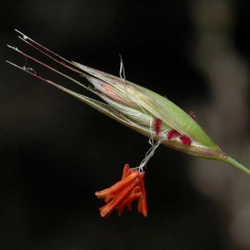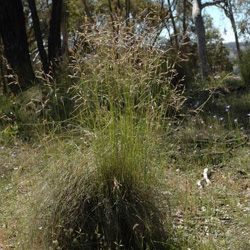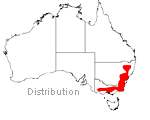Rytidosperma pallidum
 |
 |
Previously known as Joycea pallida and before that, Danthonia pallida
Redanther or Silvertop Wallaby Grass
Rytidosperma pallidum (R.Br.) A.M.Humphreys & H.P.Linder
Rytidosperma pallidum is an Australian tussock grass within the Poaceae (grass species) family. It is commonly known as one of the many Wallaby grass species and often referred to as Redanther or Silvertop Wallaby grass. Previously to 1996 it was known as Danthonia pallida.
 R. pallidum is an Eastern Australia species which extends through open forests and woodlands in New South Wales, Victoria and the Australian Capital Territory. A dominant understorey species it prefers shallow and stony soil. It can be found growing quite happily on Black Mountain in and around the Australian National Botanic Gardens in the ACT.
R. pallidum is an Eastern Australia species which extends through open forests and woodlands in New South Wales, Victoria and the Australian Capital Territory. A dominant understorey species it prefers shallow and stony soil. It can be found growing quite happily on Black Mountain in and around the Australian National Botanic Gardens in the ACT.
This grass forms dense tussocks with pale blue-green leaves and a very tall inflorescence (flower spike). It flowers from November through to January and its seeds have distinct and prominent orange-red coloured anthers.
R. pallidum can be an elegant and distinctive feature plant in the home garden. It can also be used within a revegetation situation restoring understorey in degraded bushland. This species can be grown in a garden bed against a fence line to soften hard edges or in pots in a balcony, courtyard or patio situation.R. pallidum, like many other tussock grasses, may attract small grain feeding birds to your garden. When planted in garden beds it may provide refuge for small lizards within and between the tussocks.
This species can be grown from seed however buying seed in small amounts for the home garden is currently difficult. Seed must be collected legally and a check on your states legal requirements is advised before collecting seeds or plant material from the wild for any native species.
If growing from seed all that is required are basic horticultural skills, a basic seed mix and attention to ensure seedlings do not become over wet or dry out. Clumps can also be divided to create more individuals. This species may also be found in specialist native nurseries where it may be sold under its former name Danthonia pallida or the common name Wallaby grass which covers serval different species with very different characteristics.
One problem that puts people off growing native tussock grasses is the unkempt appearance many get after the flowering period. This can easily be overcome by cutting the tussock back in a dome like fashion a few inches high at the centre. This will encourage new green growth and remove dead foliage.
Caution: grass pollen (but not generally grass seeds) can effect asthma and hay fever suffers during the flowering season. If planted in pots this grass species can be moved away from the house during this period and returned once seeds have formed.
Text by Katharine O’Bryan (2006 Student Botanical Intern)
Name meaning: Rytidosperma pallidum, Joycea pallidaRytidosperma – from the Greek 'rhytidos' = wrinkled and 'sperma' = seed; referring to the character of the seed of the type-species which which proved to be a misinterpretation. Joycea – after Dr. Joyce W. Vickery (1908 – 1979) a leading Australian botanist who had a major study focus on the grass family Poaceae pallida – meaning pale |
References
Australian National Botanic Gardens website available at http://www.anbg.gov.au [Accessed 9 th February 2006]
Eddy, D; Mallinson, D; Rehwinkel, R & Sharp, S (1998) Grassland Flora; a field guide for the Southern Tablelands NSW and ACT, Environment ACT, Canberra.
The Linnean Society of New South Wales, (n.d.) Research Grants, webpage available at http://www.acay.com.au/~linnsoc/grants.html [Accessed 9 th February 2006]
Wapstra, M., A., and H.(2010) 'Tasmanian Plant Names Unravelled', Fullers Bookshop, Launceston, Tasmania
Watson, L & Dallwitz M.J (n.d.) The Grass Genera of the World, webpage available at http://delta-intkey.com/grass/www/joycea.htm [Accessed 9 th February 2006]
![An Australian Government Initiative [logo]](/images/austgovt_brown_90px.gif)

